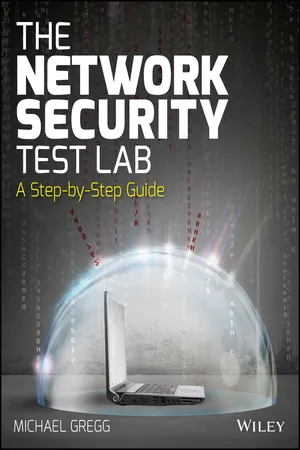
- English
- ePUB (mobile friendly)
- Available on iOS & Android
About this book
The ultimate hands-on guide to IT security and proactive defense
The Network Security Test Lab is a hands-on, step-by-step guide to ultimate IT security implementation. Covering the full complement of malware, viruses, and other attack technologies, this essential guide walks you through the security assessment and penetration testing process, and provides the set-up guidance you need to build your own security-testing lab. You'll look inside the actual attacks to decode their methods, and learn how to run attacks in an isolated sandbox to better understand how attackers target systems, and how to build the defenses that stop them. You'll be introduced to tools like Wireshark, Networkminer, Nmap, Metasploit, and more as you discover techniques for defending against network attacks, social networking bugs, malware, and the most prevalent malicious traffic. You also get access to open source tools, demo software, and a bootable version of Linux to facilitate hands-on learning and help you implement your new skills.
Security technology continues to evolve, and yet not a week goes by without news of a new security breach or a new exploit being released. The Network Security Test Lab is the ultimate guide when you are on the front lines of defense, providing the most up-to-date methods of thwarting would-be attackers.
- Get acquainted with your hardware, gear, and test platform
- Learn how attackers penetrate existing security systems
- Detect malicious activity and build effective defenses
- Investigate and analyze attacks to inform defense strategy
The Network Security Test Lab is your complete, essential guide.
Frequently asked questions
- Essential is ideal for learners and professionals who enjoy exploring a wide range of subjects. Access the Essential Library with 800,000+ trusted titles and best-sellers across business, personal growth, and the humanities. Includes unlimited reading time and Standard Read Aloud voice.
- Complete: Perfect for advanced learners and researchers needing full, unrestricted access. Unlock 1.4M+ books across hundreds of subjects, including academic and specialized titles. The Complete Plan also includes advanced features like Premium Read Aloud and Research Assistant.
Please note we cannot support devices running on iOS 13 and Android 7 or earlier. Learn more about using the app.
Information
CHAPTER 1
Building a Hardware and Software Test Platform
Why Build a Lab?
NOTE A laboratory is a controlled environment in which unexpected events are nonexistent or at least minimized. Having a lab provides a consequence-free setting in which damage that might result from experimentation is localized (and can, it is hoped, be easily corrected).
- Certification
- Job advancement
- Knowledge
- Experimentation
- Evaluation of new tools
Table of contents
- Cover
- Titlepage
- About the Author
- Credits
- Acknowledgments
- Introduction
- Chapter 1: Building a Hardware and Software Test Platform
- Chapter 2: Passive Information Gathering
- Chapter 3: Analyzing Network Traffic
- Chapter 4: Detecting Live Systems and Analyzing Results
- Chapter 5: Enumerating Systems
- Chapter 6: Automating Encryption and Tunneling Techniques
- Chapter 7: Automated Attack and Penetration Tools
- Chapter 8: Securing Wireless Systems
- Chapter 9: An Introduction to Malware
- Chapter 10: Detecting Intrusions and Analyzing Malware
- Chapter 11: Forensic Detection
- EULA